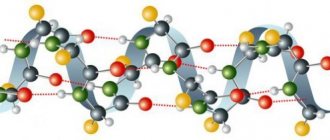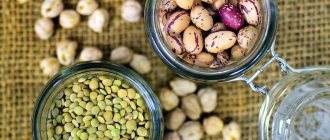Amino acids are organic compounds, “building blocks” for the construction of vitamins, hormones, proteins and pigments. In their pure form they look like white crystals and have a sweet and sometimes bitter taste. Humans and animals do not synthesize most amino acids on their own, like most microorganisms or plants do. Therefore, a person needs to obtain most of the important elements from food or in the form of supplements. In this article, we propose to consider the amino acid composition of additives using the example of EXPONENTA fermented milk drinks, as an option for the fastest balance.
This article addresses the following issues:
- What are the types of amino acids and what does protein have to do with it?
- How amino acids affect the body;
- About the daily norm of amino acids and where they are found, in what food;
- Supplements with amino acids: who cares about them?
Proteins and amino acids
Proteins are absolutely necessary substances for the existence of the body. They participate in metabolic processes, they make up hormones and antibodies, blood cells and muscle fibers. However, a piece of well-fried beef by itself will never become the building material for bodybuilder Kolya’s biceps. First, the meat must be digested - that is, with the help of digestive enzymes, the protein contained in the meat must be broken down into its constituent amino acids, and then new proteins must be assembled from these “building blocks” - already in the coli muscle.
Amino acids: general characteristics and functions
Amino acids are the building blocks of protein
Amino acids are organic substances that are called the “building” particles of protein.
The functions they perform:
- Protein is synthesized from them.
- With their help, the brain works fully.
- Amino acids help vitamins fulfill their purpose and work at full strength.
Also, people involved in sports who want to lose weight or gain weight focus on the consumption of proteins and amino acids. Such measures help to achieve the desired result quickly and without harm to health.
The chemical definition of amino acids is as follows: organic compounds whose molecules contain amino groups and carboxyl groups. The simplest representative is aminoethanoic or aminoacetic acid.
About 150 different amino acids are found in nature. Alpha amino acids are of greatest importance, since they are the basis of the most important molecules of living nature - proteins.
Amino acids perform the function of protein synthesis in living organisms. Animals and people get them through food containing protein.
Some artificially isolated or synthesized amino acids, an example is glycine, are used in medicine.
Amino acid derivatives are used for the synthesis of fibers, an example is nylon.
Who is who
Tryptophan is used by the body to produce serotonin, the good mood hormone, and is involved in the synthesis of vitamin B3. Leucine helps restore muscle and bone tissue and stimulates the production of growth hormones. Isoleucine is necessary for hemoglobin synthesis, body endurance and muscle tissue restoration. Valine is important for muscle metabolism and recovery after injury. Threonine regulates protein metabolism in the body, participates in the metabolism of fats in the liver and the functioning of the immune system. Lysine helps absorb calcium and nitrogen, participates in the production of antibodies, hormones, enzymes, and restoration of body tissues after damage. Methionine protects the walls of blood vessels from cholesterol deposition and is involved in the digestion process. Phenylalanine is a derivative substance for the synthesis of neurotransmitters necessary for memory, learning ability, and mood. Arginine stimulates the body's immune system, improves reproductive functions in men, and helps eliminate harmful substances from the body.
Daily norm
A healthy body must receive all the necessary amino acids
For each amino acid there is a certain daily requirement:
- For Valin it is 2.5 grams.
- For Isoleucine – 2 grams.
- Leucine requires 4.5 grams.
- The daily norm of Lysine is 4 grams.
- Methionine requires about 2 grams per day.
- The appropriate dosage of Tyrosine is 4.4 grams.
- Threonine must be consumed per day 2.4 grams.
- Tryptophan is enough and about 1 gram.
- Phenylaniline is required in a dosage of 4.4 grams.
Required amount of essential amino acids per day:
| Amino acid | In grams | In animal products | In plant products |
| Tryptophan | 1 | 130 g cheese | 2 kg carrots, 500 g beans |
| Leucine | 5 | 250 g beef | 1.2 kg buckwheat, 400 g peas |
| Isoleucine | 3,5 | 120 g chicken | 1.4 kg rye bread, 450 g peas |
| Valin | 3,5 | 300 g beef | 800 g pasta, 400 g peas |
| Threonine | 2,5 | 350 cod | 3 kg potatoes, 400 g beans |
| Lysine | 4 | 200 g beef | 1.5 kg oatmeal, 400 peas |
| Methionine | 3 | 300 g chicken | 1.3 kg rice, 1.8 kg peas |
| Phenylalanine | 3 | 300 g chicken | 1 kg pearl barley, 400 g peas |
| Arginine | 4 | 250 g chicken | 600 g rice, 250 g peas |
Please note that essential amino acids are contained in foods not one at a time, but in a certain combination. Animal products contain all nine amino acids. And about 300 grams of beef or 500 grams of fermented milk products is enough to get their daily requirement.
People who eat only plant foods will have a more difficult time - they must include grains, legumes and vegetables in their diet daily in large enough quantities so as not to lack essential amino acids.
By the way, the only protein that is as close as possible to animal protein in composition is found in legumes - beans, soybeans, lentils, peas. But, unfortunately, it contains practically no amino acid methionine, which, for example, grain products are rich in.
Foods containing amino acids
Sources of the amino acid valine:
- meat;
- peanut;
- dairy products.
Sources of isoleucine:
- nuts;
- seeds;
- lentils;
- fish.
Foods containing amino acids
Products that help meet the need for phenylalanine:
- almond;
- bakery products.
Eggs and milk will help fill the need for Lysine.
What are amino acids?
Amino acids are structuring elements containing nitrogen, carbon, hydrogen, oxygen with a diverse group of side chains that form peptides and proteins . They represent 75% of body weight, 95% of muscles, including the heart muscles. In addition, 100% of hormones and neurotransmitters are produced from amino acids. [3]
Our DNA encodes 20 amino acids that are involved in protein synthesis, 9 of which are essential . This means that the 9 essential amino acids must be taken through food or supplements. [1] Amino acids are divided into essential and non-essential , as well as conditionally essential amino acids . While the body lacks 1 essential or non-essential amino acid, the remaining 19 amino acids are practically not used . [4]
Essential amino acids include [2]:
- histidine
- isoleucine
- leucine
- lysine
- methionine
- phenylalanine
- threonine
- tryptophan
- valine
Essential amino acids differ depending on type and age. Therefore, some experts consider only 8 amino acids , excluding histidine. However, the scientific community works on all 9 essential amino acids , with no exceptions. [3]
Nonessential amino acids are those that the body can produce on its own, even if not taken from food. This list includes alanine, arginine, aspartic acid, cysteine, glutamic acid, glutamine, glycine, proline, serine and tyrosine. [2]
Conditionally essential amino acids are produced independently if the body is not exposed to disease or stress. This category includes arginine, cysteine, glutamine, tyrosine, glycine, ornithine, proline and serine. [2]
Sources[edit | edit code]
- Wolfe RR: Regulation of muscle proteins by amino acids. J Nutr 2002, 132(10):3219S-24S.
- Tipton KD, Borsheim E, Wolf SE, Sanford AP, Wolfe RR: Acute response of net muscle protein balance reflects 24-h balance after exercise and amino acid ingestion. Am J Physiol Endocrinol Metab 2003, 284(1):E76-89.
- Biolo G, Williams BD, Fleming RY, Wolfe RR: Insulin action on muscle protein kinetics and amino acid transport during recovery after resistance exercise. Diabetes 1999, 48(5):949-57.
- Borsheim E, Tipton KD, Wolf SE, Wolfe RR: Essential amino acids and muscle protein recovery from resistance exercise. Am J Physiol Endocrinol Metab 2002, 283(4):E648-57.
- Kobayashi H, Borsheim E, Anthony TG, Traber DL, Badalamenti J, Kimball SR, Jefferson LS, Wolfe RR: Reduced amino acid availability inhibits muscle protein synthesis and decreases activity of initiation factor eIF2B. Am J Physiol Endocrinol Metab. 2003, 284(3):E488-98.
- Miller SL, Tipton KD, Chinkes DL, Wolf SE, Wolfe RR: Independent and combined effects of amino acids and glucose after resistance exercise. Med Sci Sports Exerc 2003, 35(3):449-55.
- Rasmussen BB, Tipton KD, Miller SL, Wolf SE, Wolfe RR: An oral essential amino acid-carbohydrate supplement enhances muscle protein anabolism after resistance exercise. J Appl Physiol 2000, 88(2):386-92.
- Rasmussen BB, Wolfe RR, Volpi E: Oral and intravenously administered amino acids produce similar effects on muscle protein synthesis in the elderly. J Nutr Health Aging 2002, 6(6):358-62.
- Esmarck B, Andersen JL, Olsen S, Richter EA, Mizuno M, Kjaer M: Timing of postexercise protein intake is important for muscle hypertrophy with resistance training in elderly humans. J Physiol 2001, 535(Pt 1):301-11.
- Garlick PJ: The role of leucine in the regulation of protein metabolism. J Nutr 2005, 135(6 Suppl):1553S-6S.
- ↑ 11,011,1 Garlick PJ, Grant I: Amino acid infusion increases the sensitivity of muscle protein synthesis in vivo to insulin. Effect of branched-chain amino acids. Biochem J 1988, 254(2):579-84.
- Campbell B, Kreider RB, Ziegenfuss T, La Bounty P, Roberts M, Burke D, Landis J, Lopez H, Antonio J: International Society of Sports Nutrition position stand: protein and exercise. J Int Soc Sports Nutr 2007, 4:8.
- Tipton KD, Borsheim E, Wolf SE, Sanford AP, Wolfe RR: Acute response of net muscle protein balance reflects 24-h balance after exercise and amino acid ingestion. Am J Physiol Endocrinol Metab 2003, 284:E76-E89.
- Butenko L.I., Ligai L.V. RESEARCH OF THE CHEMICAL COMPOSITION OF SPROUTED SEEDS OF BUCKWHEAT, OATS, BARLEY AND WHEAT // Fundamental Research. – 2013. – No. 4 (part 5). – pp. 1128-1133; URL: www.rae.ru/fs/?section=content&op=show_article&article_id=10000585 (access date: 11/12/2013)
Amino acids and the body
Amino acids are divided into three groups: non-essential ones are synthesized in the body; irreplaceable - not synthesized directly, therefore they must enter the body with food; conditionally replaceable - obtained in the body through synthesis, but in insufficient quantities. Of these, the human body synthesizes twelve types of amino acids on its own, and we receive another 8 along with protein foods. EXPONENTA has a laboratory research protocol that confirms the presence of all 8 essential amino acids in the company's drinks. If suddenly the set is not complete, the metabolism will be disrupted and hormonal failure will occur.
But what exactly do amino acids provide to the body?
We tell you:
- Isoleucine - skin regeneration depends on it, but that's not all. Isoleucine helps the body recover from blood loss, burns, and sprains. Regulates blood sugar levels and protects against excessive serotonin production.
- Leucine - used to treat anemia and liver diseases.
- Lysine - affects the condition of hair, height and body weight, appetite. Helps absorb calcium and improves concentration. A lack of lysine leads to fatigue, weakness and fatigue, increases irritability and will lead to problems in the sexual sphere.
- Methionine helps increase life expectancy, and also helps lower blood cholesterol and reduce fat deposits. It also improves liver function and acts as an antidepressant.
- Phenylalanine - affects the functioning of nerve cells, stabilizes mood, improves memory and increases sensitivity.
- Threonine - promotes the synthesis of collagen and elastin, helps fat and protein metabolism, helps the liver and stimulates the immune system.
- Tryptophan - affects the production of serotonin, the good mood hormone. Helps fight obsessive fear, tension, withdrawal symptoms and various poisonings.
- Valine - affects the growth and creation of tissues. It is a source of energy in the muscles and helps keep serotonin at high levels.
However, you shouldn’t overuse amino acids either, because an excess of certain elements leads to negative consequences - from early gray hair to a serious risk of stroke or heart attack. Everything needs balance - we’ll tell you about these tricks now.
Benefits of Taking Essential Amino Acid Supplements
While essential amino acids can be found in a wide range of foods, taking concentrated doses in supplement form is associated with several health benefits.
May help improve mood and sleep
Tryptophan is essential for the production of serotonin, a chemical that acts as a neurotransmitter in your body.
Serotonin is an important regulator of mood, sleep and behavior.
While low serotonin levels are associated with depressed mood and sleep disturbances, several studies have found that taking tryptophan supplements may reduce symptoms of depression, boost mood, and improve sleep (, , , , ).
A 19-day study of 60 older women found that 1 gram of tryptophan per day resulted in increased energy levels and improved happiness compared to placebo ().
Can improve performance in sports
The three essential branched chain amino acids are widely used to relieve fatigue, improve athletic performance, and promote muscle recovery after exercise.
In a study of 16 weightlifters, branched chain amino acids were found to improve muscle performance and recovery, and reduce muscle soreness compared to a placebo ().
A recent review of eight studies found that taking branched-chain amino acid supplements stimulated muscle recovery and reduced soreness after exhaustive exercise ().
Additionally, 4 grams of leucine per day for 12 weeks increased strength in untrained men, showing that essential amino acids may also benefit non-strength athletes ().
May prevent muscle loss
Loss of muscle mass is a common side effect of long-term illness and bed rest, especially in older adults.
Essential amino acids have been found to prevent muscle breakdown and maintain lean body mass.
A 10-day study of 22 older adults on bed rest found that those who received 15 grams of an essential amino acid mixture maintained muscle protein synthesis, while those receiving a placebo decreased muscle protein synthesis by 30% ().
Essential amino acid supplements have been found to be effective in maintaining lean body mass in older adults and athletes (, ).
May promote weight loss
Some human and animal studies have shown that branched chain essential amino acids may be effective in promoting the loss of body fat mass.
For example, an eight-week study of 36 strength-training men found that taking 14 grams of branched-chain amino acids per day significantly reduced body fat percentage compared to taking whey protein or sports drinks ().
A study in rats found that a diet supplemented with 4% leucine reduced body and fat mass ().
However, other studies examining the potential link between branched chain amino acids and weight loss have been inconsistent. More research is needed to determine whether these amino acids can promote weight loss (, ).
Conclusion:
Taking supplements of certain essential amino acids can help improve your mood, enhance exercise performance, prevent muscle loss, and promote weight loss.
Lack of amino acids
Lack of amino acids leads to disorders in the body
The human body is in motion, experiences stress, performs work, learns, and improves. All processes require energy, beneficial microelements and a balanced diet that can meet the body’s needs.
As a result of the modern way of life, a constant lack of time to take care of themselves, a mountain of work, pressure from superiors and many other factors, people turn to unhealthy eating, which only brings harm.
They completely forgot about the daily intake of healthy foods, fats, proteins and carbohydrates. Because of this, there is a lack of amino acids. Later, complaints are received about fatigue, depression, lack of strength and energy, absent-mindedness, lack of concentration, and perseverance.
Symptoms indicating a lack of essential amino acids
If the body lacks essential amino acids, a person may experience the following symptoms:
Where are the essential amino acids for humans found?
In order to have enough microelements and the body to work without failures, you need to understand where the essential amino acids are contained, which are important for a person to consume, and what norm is needed. As well as where proteins are found - in what food.
Let's figure it out.
The Moscow Institute of Nutrition of the Russian Academy of Medical Sciences says the norm for an adult with low or average physical activity is 1.5 grams of protein per 1 kg. weight. But keep in mind that different foods are absorbed differently, so the value of protein in them is different:
Protein absorption table or where proteins are found:
- 95% - eggs, milk and dairy products;
- 90–70% - fish (especially cod) and meat (chicken, beef);
- 70–40% - flour products;
- 60–30% - cereals, rice, nuts, vegetables and legumes.
Thus, it is clear in which products to look for the element necessary for the body.
In addition to the pure product, we recommend paying attention to whey protein (protein), the so-called gold standard of protein. In its pure form, it is obtained during the production of dairy products and is often used as a sports nutrition or additive in food production. The absorption rate of whey protein is up to 100%.
By the way, EXPONENTA fermented milk products contain whey protein concentrate and are well digestible, therefore ideal for obtaining the daily requirement of amino acids.
As you can see, the food you eat directly affects not only your well-being, but also your quality of life, so it is vital to diversify your diet with clean cereals, meat and dairy products.
Try to balance your diet so that every calorie is filled with those microelements that will benefit you.











